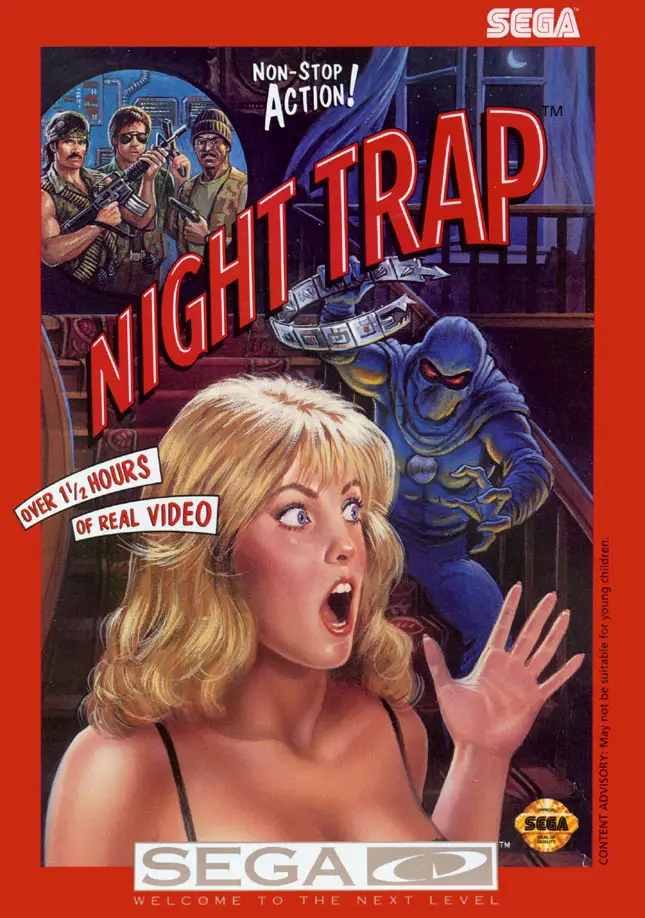Who’s Afraid of Night Trap?
Could a game so controversial that it helped create the ESRB rating system have something more diabolical to hide than its torturous death scenes?
By Al Vanderklipp, University of Michigan
It was 2007 when I purchased a copy of Night Trap from a strange old man in a black market bazaar.
It sat untouched on my shelf for years, radiating evil and biding its time until the day I became so desperate for a Halloween-themed topic that I reached for the garish red box. I prepared the game and pressed POWER. The ancient mechanisms inside the Sega CD ground to life. My hands, usually moistureless and stoic, began to sweat and tremble. Just what was I getting myself into?

Night Trap is innovative, but straightforward; unlike a regular video game, the player uses a security-monitor setup. Each screen displays the static image of a room in a picturesque villa, and each room is rigged with booby traps. It plays like a voyeuristic interactive horror movie: Oblivious young women fall victim to a gang of sneaky, blood-sucking perverts called Augers, unless the player manages to trap the intruders. The challenge comes in monitoring every room at once—it’s impossible to know when and where the Augers will appear, unless you’ve played the game before.
While monitoring the feed, I watched as one-by-one the busty co-eds were taken by masked invaders. Nothing seemed out of the ordinary until the main character, Kelly, was sucked into a trap door and spiraled into a black abyss. Foul smelling smoke billowed up from under my TV; I began to feel dizzy, so I turned off the console. In the following days, I began experiencing all the trappings of a classic curse. Rotating head, uncontrollable urination, ectoplasmic vomit, guttural foreign tongues—the whole shebang. I spent thousands of dollars on traveling psychics, exorcists, shamans and swamp hags, but to no avail. Finally, during a lull in my symptoms, I decided to figure out a cure myself.
At the local library, I was directed to a flight of slick concrete steps descending into the public archives, a damp and dripping room 45 degrees cooler then the rest of the building. I surveyed the dismal cellar. Fluorescent lights flickered ominously, barely illuminating the microfiche-readers and the navy cabinets that lined the walls. In one corner, a rat pulled what might have been a finger into a large crack in the floor.
“My tax dollars at work,” I sneered. I felt a hot pain in my cursed ass, where my flesh had begun to rot. It was time to get to work.
Feverishly, I pored through seven years of newspaper entertainment sections, looking for anything that would explain my freakish paranormal symptoms. Occasionally, Night Trap was mentioned for its controversies; referred to as “sick,” “shameful” and “disgusting,” the game was at the forefront of the political movement to ban violent video games, which eventually resulted in the ESRB rating system. Then it hit me: What better way to ensure a game’s demise than by placing a debilitating curse on those who dared to play it?
At first, I suspected Senator Joe Lieberman, one of the game’s biggest opponents in congress. But when I called the former Democratic Vice Presidential nominee’s office, his icy secretary assured me he was neither dead, nor dabbling in the occult in any way. Unconvinced, I put a question mark next to his name on my list of suspects and moved on.
Suddenly, a file drawer flew open behind me. I sat, frozen, as a roll of microfilm whirred into the air, unwinding itself and clattering to the floor behind me. The gray plastic seemed to pulse, picking up pace with my own escalating heartbeat. With trembling hands, I grasped the spool and placed it under the light.
Above a thin obituary was a picture of a familiar-looking woman. After a moment, I realized it was Kelly, the woman who perished in the bottomless chasm moments before I was cursed. Her real name was Dana Plato; she had seen success as a child actress on the preachy sitcom “Diff’rent Strokes,” but early drug addiction had sent her careening off-track. A stint on Night Trap was the final nail in the coffin for ailing career. Plato died of a drug overdose in 1999, leaving behind a legacy tarnished by the Sega CD game and softcore adult movies. I understood what had to be done.
Back home, I re-booted Night Trap, working for hours memorizing every trap, every point of entry for the vampires. I ignored the other girls, whose anguished spirits didn’t inhabit the disc, guiding only Plato to safety. “I knew I could count on you,” she said, moments before turning and skipping down the stairs. “You were wonderful.” The credits rolled, and I felt the weight of the curse lift from my broad shoulders as Dana ascended into heaven, finally free from the game that had tortured her in death as it had in life.









